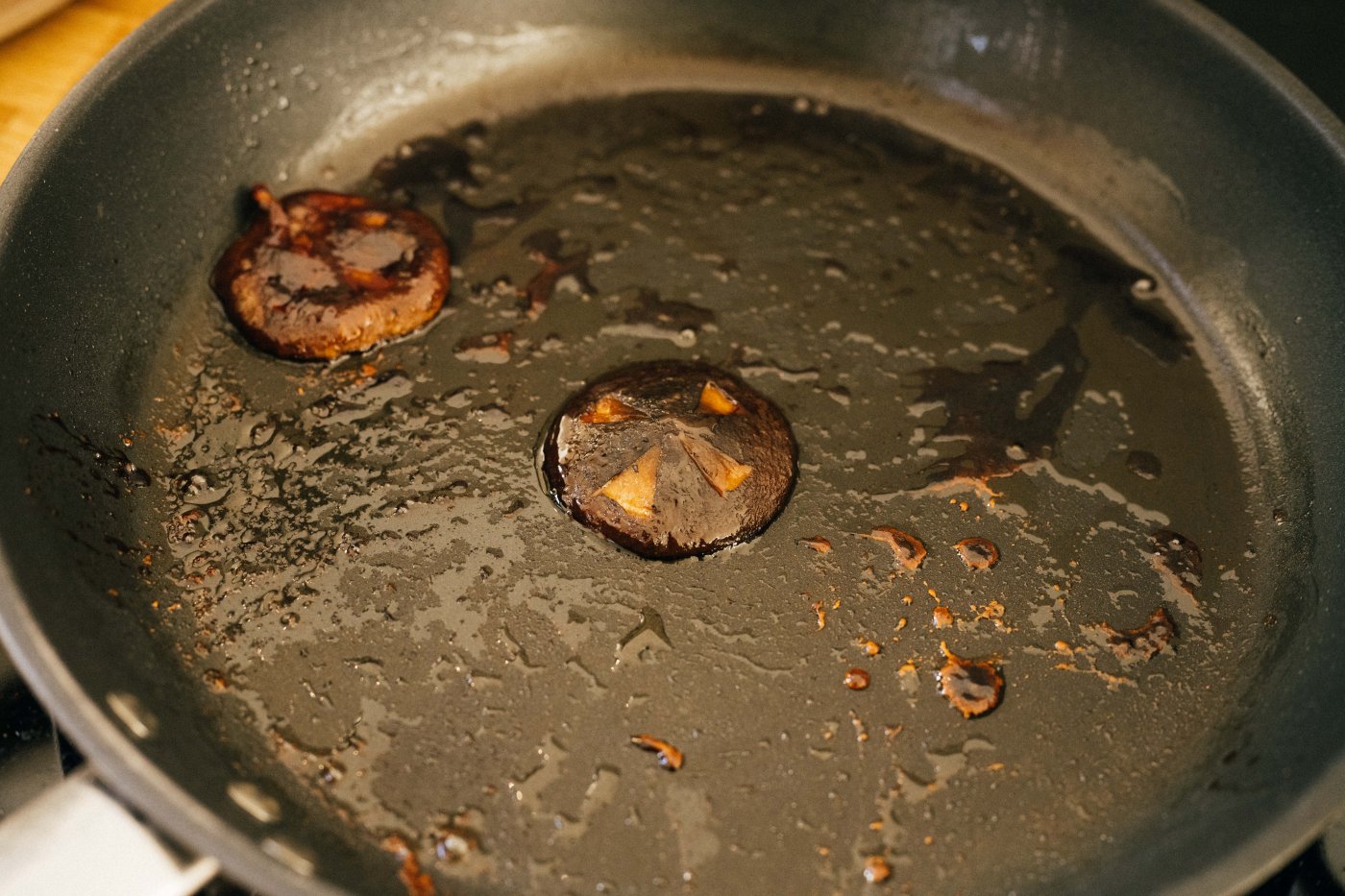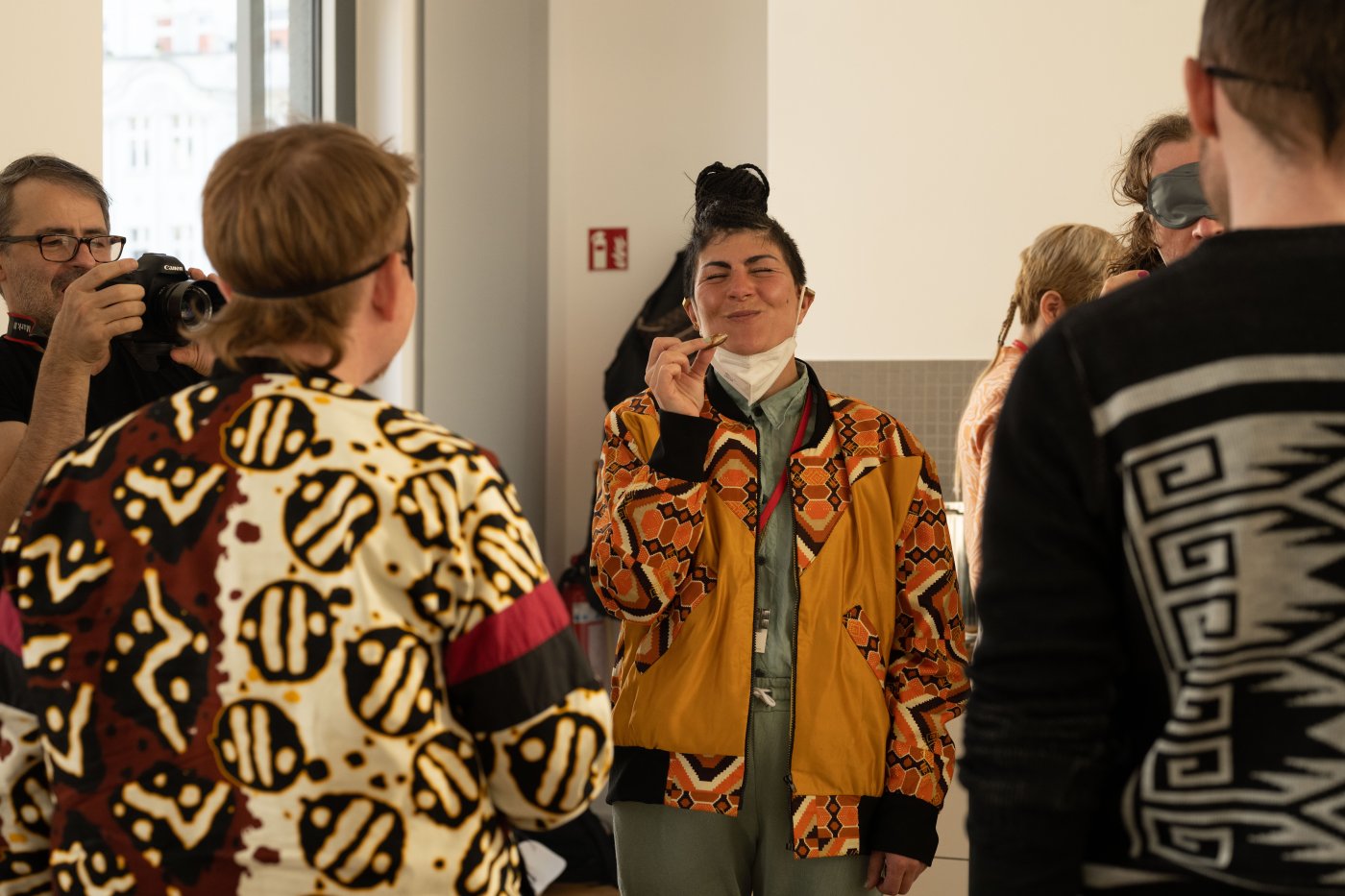3. MATERIAL & SPIRITUAL CALORIES




Outside my verbose flesh, I am on the side of the world.
— Michel Serres
The project nourishes the idea that the body’s chemistry is changed both by the material calories of what we eat and the spiritual calories of how we eat, how sociality, pleasure, and storytelling nourish us as much as the proteins, sugars, and amino acids that we consume.
The concept of taste comes from the Latin sapere, ‘to taste,’ which is etymologically related to the English word sapience, or wisdom, as well as the designation of the human species as Homo sapiens, literally ‘wise human.’ Working with taste in a performative context, I produce a transmission of knowledge through embodied sensorial means.
In the act of eating, taste is part of several aspects of the experience. Our taste buds have receptors for flavour, and yet these constitute only one third of the papillae on the tongue. The other two thirds (filiform papillae) are dedicated to touch, to texture and tactility. Hot and cold, slippery, rough, smooth. Wet, dry, sticky, floury, crisp, juicy, soft. The taste of skin, of another tongue, of salt and sweat. The smell of air. The smell of bread, polished nails, synthetic rose.
The olfactory component of taste, often overlooked, is crucial. Without it, this sense would be so diminished it would render the experience lacklustre at best. Olfaction and gustation are intimately connected to the oldest ‘reptilian’ parts of the brain, the amygdala and hippocampus, which deal with emotion and memory. The relation of olfaction to long term memory is well studied yet little understood; our sense of smell continues to elude modern science. Unlike vision, which is or appears to be more objective, and thus which lends itself more clearly to critical theory, olfaction has an ambiguous cultural status that belies its political function and its emancipatory potential.
The word ‘nostalgia’ is intimately linked to olfaction and taste. The neologism from the eighteenth century was invented for the malady suffered by European mercenary soldiers, who were literally sick from longing for the familiar tastes and smells of their motherland: nostos - algos is the pain of home. Home comes to reclaim its place in the body as loss. Smell and taste memory are the madeleines of Proust as well as the demographic upheaval that saw countless people move from their rural homelands to the cities in search of work. The history of smell in the modern era is in fact one of the most important poetic indicators of the loss of the cyclical in favour of the linear.
Taste, smell, touch: the senses considered most anti-intellectual are, in this project, the ripest for transmitting embodied knowledge, for inducing a looser and more cyclical temporality, for creating connection between the biotic and the abiotic.
Can we do this with early life? Can we taste ancient time, Dilated or condens’d, bright or obscure? We begin with single-celled cyanobacteria in an anaerobic, hyperthermic, hyperbaric environment. A mutation allowing them to generate more energy creates oxygen as a by-product. Slowly the sea and atmosphere oxygenate, causing the iron in rocks to rust. The anaerobic bacteria surge and then die en masse as their oxygenated environment becomes toxic. A band of rust is formed. Life returns to normal, the bacteria flourish again, die out. Another band of rust. And so we go on, until more mutation permits aerobic cyanobacteria to spread over the Earth. Rust makes rock friable, disintegrate, become soil. Iron in the soil is necessary for plant life, and the animals that eat it, necessary in blood, in breathing.
and thus the least things in the universe must be secret mirrors to the greatest.
— Jorge Luis Borges
We begin at the table. Tasting as a way of experiencing the flavour of ancient time lingering in the sociality of a shared meal: the bodies at the table, the historic origins of the elements in our food. Can we take a bite of our shared ancient history? And can that experience create a sense of interconnectedness that is deeply political? Employing my skills as an artist, a chef, and an academic, I would create a choreography of the table so that these heterogenous moments in time dissolve into each other, so that the tasting tongue is tied to the inorganic inside all organic life; to the laughter and warmth of the bodies here and now; to the conditions of then. Tongue-tied: being lost for words, speechless. For us it might mean: filled with non-linguistic speech.
To marry the flesh, the blood, the breath to the same biochemical processes that carry us through the world from which we arise, and from which we are not separate. To taste them, to allow the angels to enter our lungs, our stomachs, to travel across our tongues. To marry the sensual and the cybernetic, to eat the ones and zeroes, to linger over the flavours of different times. To create an ethics of attention through an attention to taste.
In the name of nothing, it was time to eat. In the name of no one, it was good. Without any dreams. And we were slowly rising to the day, slowly becoming anonymous, growing, adults, to the level of possible life. Then, like rustic noblemen, we accepted the food.
— Clarice Lispector
The shared meal is more than an experience of pleasure, more than solidarity. It is a powerful symbol of what cannot be repeated, of lived connections between beings both inorganic and organic. Metabolism as the reproduction of life. Michel Serres explains the ritual of the guest and the host, who, upon parting, would break a tessera in honour of what was shared: “the random fracture of this terracotta piece, broken to be shared, follows a fine jagged outline, one that’s haphazard, complicated, inimitable, specific.” The word symbolon, whose Greek roots, συν-βολον [sým-bolon], mean ‘a throwing together.’ The word came to mean a key, a passcode, a passe-d’entrer. Upon meeting again, the edges of the tessera were reunited. A recognition rather than a repetition of what was shared, a deepening of the connection. “Since a password is a contracted form of a certification of legitimacy or rightness, symbolon then came to signify a compression of meaning into a recognisable (decodable) image or depiction of some kind, whence the present signification of the word symbol.”
In a very basic sense, a symbol is a more transmissible or transportable substitute or stand-in for a process, event, im/material reality.
This project links the eating table with tabulae, with the tables and plates of scientific imagery, as an alternative to the flat consumption of visual media. This is coenesthetic consumption, tasting adjacent, crossing, overlapping temporalities: geometries of non-/life times. An alternative to the consumption and regurgitation of information, to a culture that speaks in facts as though facts might hold together a world. Mistakenly. In this case facts build a world of facts, a value of facts, of information devoid of experience. As a character in Kathy Acker’s Empire of the Senseless tells us, “knowing much information and not feeling anything doesn’t get you anywhere.”
How do we get to where we’re going? In this project, I want to give us an experience down a path that’s on the way. Not a destination, but the act of changing our bio-chemistry, creating a tessera, symbols of hope. We begin from a common ground and carry a token of recognition into future encounters. Rosi Braidotti underlines our “double commitment, on the one hand to processes of change and on the other to a strong sense of community—of our being in this together.”
The culmination of this project will be a wedding feast. The verb ‘to wed’ comes from the Old English weddian, from the Germanic base of Scots wed meaning ‘a pledge.’ What are we wedding ourselves to? What are we pledging ourselves to? Remixing a conservative and heteronormative tradition, this wedding celebration will be a vow, a token or symbol of our shared existence with the world of which we are a part and each other, giving ourselves towards a future we must mould out of what we have been given.
Your Parents is about extending the boundaries of the meal, and thus of the object, and thus of ourselves. We enter a timeline that goes down in scale to the molecular, the elemental. We ride on the vibration, the vibe of social encounter, the alchemy of the guests, the bio-alchemistry of our endorphins, rushes of dopamine, serotonin, our flushes, butterflies, our dilated pupils and saliva. We travel through non-linear time. As Ursula K. Le Guin wrote, “It takes a while to learn to talk / the long language of the rock.” This project relies on reiteration and not repetition. If repeatability is one basic condition of classical scientific experiment, this project looks to create a ‘tessera,’ a token, a fragment whose specificity is linked to a deepening of connection.
I am interested in using non-linear ritual systems as symbolons. I am deeply influenced by the study of alchemy and occult ritual, including witchcraft, folklore, tarot, and astrology. Before we pull the tarot cards and lay them on the table, we take a step out of linear time, we decide to stop its flow. We create an event, we abide by the prescripts of the ritual. The artist Suzanne Treister created the Hexen 2.0 tarot for collective readings of our cybernetic history through an alchemical, hermetic lens. Not for reading the individual, Hexen 2.0 is a collective means of “understanding how we got to where we are and where we may be able to go from here.” Using hybridised rituals, this project situates taste at its theoretical and artistic heart, as a collective endeavour that gestures towards a future.
In terms of affect, one of the most potent smells of the body is blood. Its escape to the outside takes as many forms as their uses: in the event of injury a signal of danger; in the episodic use in ritual a liquid fragment of life force; in menstruation a cyclical shedding and renewal that mirrors the phases of the moon.
It is different from other bodily exudations and excretions, typically waste products. Blood is charged, magical, holy, from ancient sacrifice to the Christian eucharist to the contemporary menstrual face masks of the new political witches. It is the iron in our blood that imparts its carnelian colour (octopus blood, which uses copper as its transport mechanism, is blue). The development of our blood vascular system has a long history that goes back to the very earliest life on earth. Life requires iron to function, from photosynthesis to DNA biosynthesis, from gene regulation to respiration and oxygen transport.
The first lifeforms developed in anaerobic conditions but due to the respiration of a new species of cyanobacteria, the oceans and then the atmosphere became oxygenated. Oxygen extraction allowed for more energy and thus more complex lifeforms were able to develop. Iron, however, is toxic under aerobic conditions. Life faced a paradox: we need oxygen and to distribute it we need iron. The complex transport mechanism in blood cells solves this problem. As a consequence, we might say that toxicity is at the heart of our health. The same oxygenation event cause the rusting of rocks, which, as John Ruskin pointed out in a lecture in 1858, “makes the ground we feed from, and nearly all the substances first needful to our existence. For these are all nothing but metals and oxygen—metals with breath put into them.” The smell of rust is similar to the smell of blood, because as blood escapes from the body it oxidises.